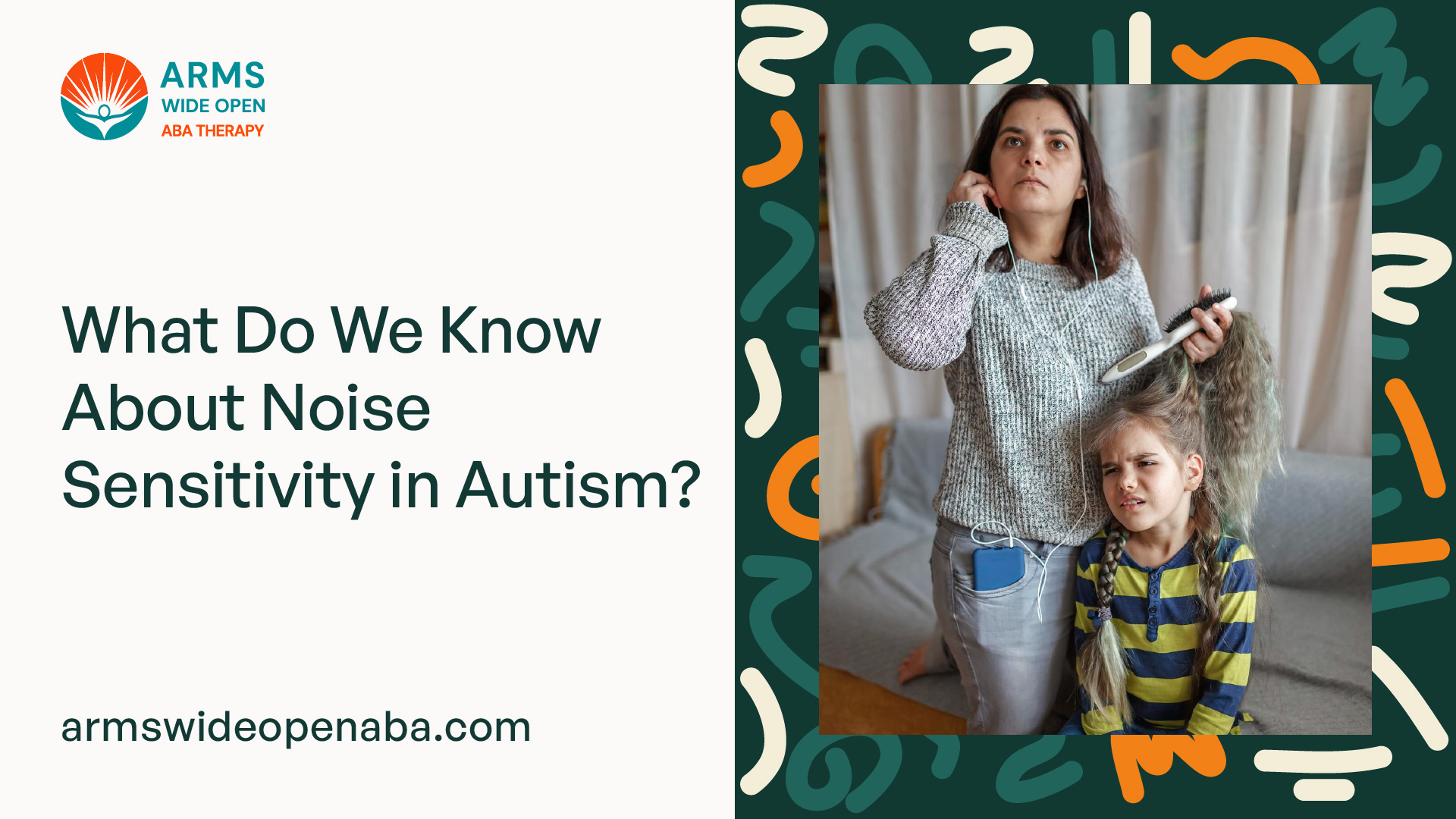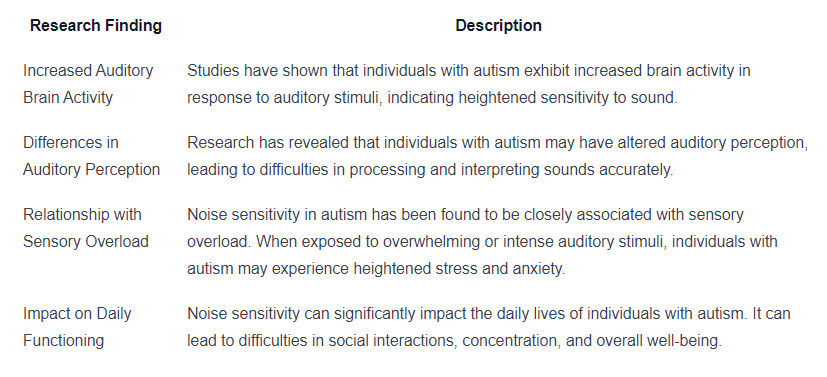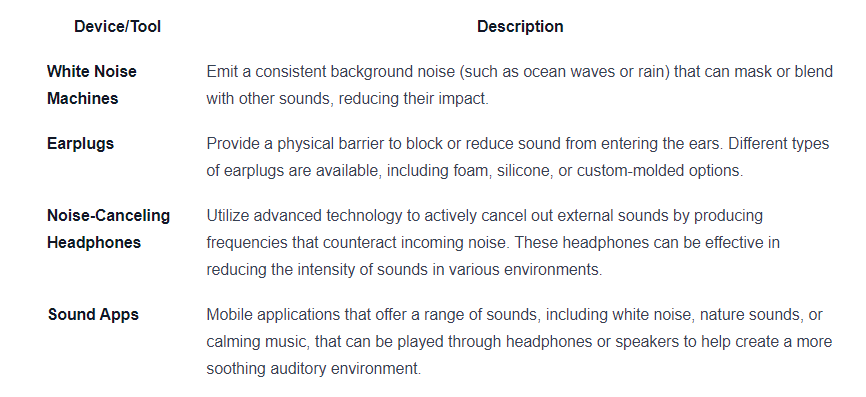What Do We Know About Noise Sensitivity in Autism?
Unveiling the mysteries of noise sensitivity in autism. Discover what we know about this unique sensory experience.


Understanding Noise Sensitivity in Autism
To unravel the mystery of noise sensitivity in autism, it is important to have a comprehensive understanding of autism spectrum disorder (ASD) and the definition of noise sensitivity.
Introduction to Autism Spectrum Disorder
Autism spectrum disorder (ASD) is a complex neurodevelopmental condition that affects individuals in various ways. It is characterized by challenges in social interaction, communication difficulties, and repetitive behaviors. ASD is a spectrum disorder, which means that it manifests differently in each individual, ranging from mild to severe.
Individuals with ASD often have unique sensory experiences, including heightened sensitivity to certain stimuli such as noise. Noise sensitivity, also known as auditory hypersensitivity, is a common sensory issue experienced by many individuals on the autism spectrum.
Definition of Noise Sensitivity
Noise sensitivity refers to an increased sensitivity or heightened response to sounds in the environment. It can cause individuals with autism to have strong reactions or discomfort when exposed to certain sounds, even at normal or lower volumes. This sensitivity can be specific to certain types of sounds or can encompass a wide range of auditory stimuli.
The impact of noise sensitivity on individuals with autism can vary. Some individuals may experience mild discomfort or annoyance, while others may have intense reactions, leading to feelings of distress, anxiety, or even physical pain. It is important to recognize that noise sensitivity in autism is not a matter of personal preference but rather a neurological response to sound stimuli.
By understanding the basics of autism spectrum disorder and the definition of noise sensitivity, we can delve deeper into the impact of noise sensitivity on individuals with autism and explore strategies to help manage and support those affected by this sensory challenge.
The Impact of Noise Sensitivity
The experience of noise sensitivity can significantly affect individuals with autism. Understanding how noise sensitivity manifests and the common triggers can help create a more supportive environment for individuals on the autism spectrum.
How Noise Sensitivity Affects Individuals with Autism
Noise sensitivity, also known as hyperacusis, is a common sensory issue experienced by many individuals with autism. It refers to an increased sensitivity to sounds that may be perceived as overwhelming or painful. The impact of noise sensitivity can vary from person to person, but it often leads to significant distress and discomfort.
For individuals with autism, noise sensitivity can interfere with their daily lives in various ways. Exposure to certain sounds may cause heightened anxiety, irritability, or even physical pain. This heightened sensitivity to noise can disrupt communication, concentration, and overall functioning.
In social situations, noise sensitivity can make it challenging for individuals with autism to engage in conversations or participate in group activities. They may struggle to filter out background noise, which can make it difficult to focus on the intended sounds or voices. This can lead to feelings of isolation and frustration.
Common Triggers for Noise Sensitivity
Noise sensitivity in autism can be triggered by a wide range of sounds. While triggers can vary from person to person, some common sources of distress include:
- Loud noises: Sudden loud noises, such as fire alarms, sirens, or clanging objects, can be particularly distressing for individuals with noise sensitivity.
- High-pitched sounds: High-pitched sounds, like the screeching of brakes or shrill voices, can be overwhelming and cause discomfort.
- Background noise: Background noises, such as the hum of fluorescent lights, air conditioning units, or crowded spaces, can be challenging to filter out and may exacerbate noise sensitivity.
- Repetitive sounds: Sounds that repeat in a pattern, like ticking clocks, tapping, or humming, can be highly distracting and distressing for individuals with noise sensitivity.
It's important to note that individual experiences and triggers can vary, and what may be distressing for one person may not affect another in the same way. Understanding and identifying the specific triggers for noise sensitivity in individuals with autism is crucial for developing effective coping strategies and creating a supportive environment.
By recognizing the impact of noise sensitivity and understanding the common triggers, we can work towards creating inclusive spaces and providing support for individuals with autism who experience noise sensitivity.

The Science Behind Noise Sensitivity
Understanding the science behind noise sensitivity in individuals with autism is essential to gain insights into this unique aspect of the condition. Let's explore the neurological factors contributing to noise sensitivity and delve into the research findings on this subject.
Neurological Factors Contributing to Noise Sensitivity
Noise sensitivity in autism is believed to be influenced by various neurological factors. Individuals with autism often demonstrate differences in sensory processing, which can affect their response to auditory stimuli. Some key neurological factors contributing to noise sensitivity include:
- Sensory Processing Differences: People with autism may have altered sensory processing, leading to heightened sensitivity to certain stimuli, including noise. This can be attributed to differences in how the brain filters and integrates sensory information.
- Hyperacusis: Hyperacusis refers to an increased sensitivity to everyday sounds. It is commonly observed in individuals with autism and can contribute to noise sensitivity. Hyperacusis occurs due to abnormal auditory processing in the brain.
- Sensory Overload: Individuals with autism may experience sensory overload, where their sensory systems become overwhelmed by the amount or intensity of sensory input. This can result in heightened sensitivity to noise and difficulties in filtering out irrelevant sounds.
Understanding these neurological factors helps us recognize that noise sensitivity in autism is a complex phenomenon influenced by various aspects of sensory processing.
Research Findings on Noise Sensitivity in Autism
Extensive research has been conducted to better understand noise sensitivity in individuals with autism. Here are some key findings:

These research findings highlight the importance of addressing noise sensitivity in individuals with autism and developing effective strategies to minimize its impact on their quality of life.
By understanding the neurological factors contributing to noise sensitivity and staying informed about the latest research findings, we can promote greater understanding and support for individuals with autism who experience this unique aspect of sensory processing.
Coping Strategies for Noise Sensitivity
Individuals with autism who experience noise sensitivity often seek coping strategies to manage their response to overwhelming sounds. Here are two effective methods that can help mitigate the impact of noise sensitivity in autism: creating sensory-friendly environments and using noise-canceling devices and tools.
Sensory-Friendly Environments
Creating a sensory-friendly environment is essential for individuals with noise sensitivity in autism. These environments aim to reduce sensory overload and create a calm atmosphere. Here are some strategies to consider:
- Designated Quiet Spaces: Designate specific areas as quiet spaces where individuals can retreat to when feeling overwhelmed by noise. These spaces should be free from excessive auditory stimulation to provide a calm and quiet environment.
- Soundproofing: Use soundproofing techniques to minimize noise from outside sources. This can include adding insulation, using acoustic panels, or sealing gaps and cracks to reduce sound transmission.
- Soft Surfaces: Incorporate soft surfaces in the environment to absorb sound and reduce echo. This can be achieved by using carpeting, curtains, or upholstered furniture.
- Noise-Reducing Headphones: Provide noise-reducing headphones or ear defenders that individuals can use to block out or reduce the intensity of external sounds. These specialized headphones can be particularly helpful in noisy environments such as classrooms, public places, or during events.
Noise-Canceling Devices and Tools
Another useful strategy for managing noise sensitivity in autism is the use of noise-canceling devices and tools. These technologies help to filter or block out unwanted sounds. Here are some commonly used options:

It's important to note that each individual with noise sensitivity may have unique preferences and responses. It's recommended to explore different coping strategies to find the ones that work best for each person. Additionally, providing support and understanding is crucial in helping individuals with autism navigate noise sensitivity and create an environment that promotes their well-being.

Support and Understanding
Living with noise sensitivity can be challenging for individuals with autism. Providing support and understanding is crucial to help them navigate their daily lives. Creating a supportive environment can greatly enhance their well-being and quality of life. Here, we will discuss the importance of support systems and ways to support individuals with noise sensitivity in autism.
Importance of Support Systems
Having a strong support system is vital for individuals with noise sensitivity in autism. This support can come from family, friends, educators, therapists, and the community. By understanding and acknowledging the impact of noise sensitivity, these support systems can play a crucial role in helping individuals cope and thrive.
Support systems can provide a safe and understanding space for individuals with noise sensitivity to express their needs and concerns. By actively listening and validating their experiences, support systems can foster a sense of belonging and reduce feelings of isolation. They can also help individuals develop coping mechanisms and strategies to manage noise sensitivity effectively.
Ways to Support Individuals with Noise Sensitivity in Autism
Supporting individuals with noise sensitivity in autism requires a comprehensive approach that takes into account their unique needs and preferences. Here are some practical ways to provide support:
- Education and Awareness: Educate yourself and others about autism spectrum disorder (ASD) and noise sensitivity. Understanding the challenges and triggers associated with noise sensitivity can help create a more empathetic and inclusive environment.
- Communication: Establish open lines of communication with the individual. Encourage them to express their feelings and concerns about noise sensitivity. Active listening and validating their experiences can foster trust and understanding.
- Sensory-Friendly Environments: Create sensory-friendly spaces that minimize overwhelming auditory stimuli. This can include designating quiet areas, using noise-dampening materials, and implementing visual cues to help individuals anticipate and prepare for potentially noisy situations.
- Collaboration: Work together with educators, therapists, and other professionals to develop individualized strategies and accommodations. This may involve implementing personalized sensory diets, providing noise-canceling headphones, or modifying the environment to reduce noise levels.
- Routine and Predictability: Establishing predictable routines can help individuals with noise sensitivity feel more secure and in control. Consistency and structure can provide a sense of stability, reducing anxiety and stress associated with unexpected noise stimuli.
- Social Support: Encourage the development of social connections and peer support networks. Connecting with others who have similar experiences can be empowering and provide a sense of belonging.
Supporting individuals with noise sensitivity in autism requires a compassionate and patient approach. By implementing these strategies and fostering a supportive environment, we can create a world that understands and embraces the unique challenges faced by individuals with noise sensitivity in autism.
Sources
https://psychcentral.com/autism/autism-sound-sensitivity
https://www.autismparentingmagazine.com/autism-sound-sensitivity/
Similar articles
We’re here to help you

Our team is here to assist you in this process. Contact us for any assistance.
it’s easy to apply
We Accept Most Insurances
Our in-network insurance partnerships make ABA therapy more accessible to families throughout our service areas.







Our Insurance Process
We'll request your insurance details to help us verify your plan's coverage for ABA therapy. Once we've received this information, we'll walk you through your benefits, including copayments, deductibles and out-of-pocket maximums, so you know what to expect in advance.
Our team will then handle the preauthorization and all the necessary paperwork.
.svg)





















.jpeg)


































.jpeg)




.jpeg)







.jpeg)











.jpeg)
















